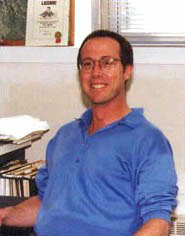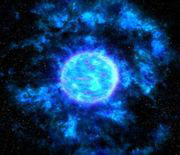A chemical analysis of meteorites almost as old as the Solar system itself suggests that rather than forming from the remnants of a supernova explosion our Solar system was formed from the wind of a nearby star some thirty times the mass of the Sun in a violent stellar nursery.
Martin Bizzarro and colleagues at the University of Copenhagen in Denmark, the University of Texas at Austin, Clemson University in South Carolina, were using mass spectrometry to look for an isotope of iron, iron-60, and its associated radioactive decay product, nickel-60, which is formed only in stars. They found that levels of this isotope were far too low to be compatible with the supernova theory of the Solar system’s formation.

Dr. Richard Carlson
Instead, they found evidence of aluminium-26, which is produced in the vast fusion reactor of stars much bigger than the Sun. This implies that our Solar system formed in a dense, swirling cluster of stars far more turbulent than the relatively passive, original supernova theory described.
However, the team did find indirect evidence of iron-60 in meteorites that date back to when the Solar system was already a million years old. This, they say means that a neighbouring supernova injected new material into the already established Solar system changing the interplanetary chemistry.

An artist’s impression of the massive star whose powerful stellar winds could have formed the Solar system
Meanwhile, in a second research paper, Richard Carlson and co-workers at the Carnegie Institution of Washington and colleagues at Jean Monnet University in Saint Etienne, France, and the Jean Monnet University in Saint Etienne, France, also report details of their studies of the stony meteorites called chondrites.
Carlson’s team has found that chondrites have a slightly different isotopic composition to the Earth, Mars, Moon and asteroids that underwent mixing in the earliest days of the Solar system. They measured levels of specific isotopes of barium, neodymium and samarium in chondrites and have found subtle clues about the early Solar system not available with older instrumentation.
Levels of neodymium and samarium isotopes in the chondrites are slightly lower than expected – by just a few tens of a part per million – compared with terrestrial samples. This, the researchers explain, supports the idea of early planetary differentiation of the Earth as denser matter sunk to the centre to form the core.
Further reading
Science, 2007, 316, 1175-1178
http://dx.doi.org/10.1126/science.1140189
Science, 2007, 316, 1178-1181
http://dx.doi.org/10.1126/science.1141040
Dr. Richard Carlson homepage
http://www.dtm.ciw.edu/carlson/
Suggested searches
meteorites
supernovae
mass spectrometry
radioactive decay
Solar system formation